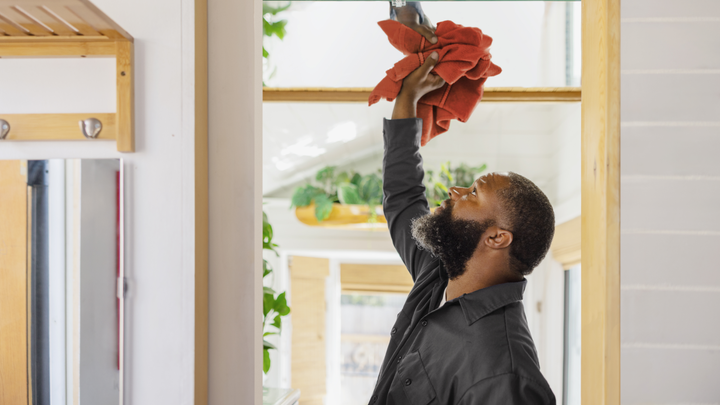Clean like a pro with these expert tips
Cleaning thoroughly between guests is an essential part of five-star hosting. One of the most common reasons guests give Hosts fewer than five stars is a lack of cleanliness.
Don’t let dust, stains, or odors tarnish your otherwise great hospitality. Try these tips from professional cleaner Diana Cruz. She and her husband clean a dozen properties for Hosts with Airbnb listings in southwestern Florida.
Use the right tools and supplies
Handle cleaning tasks with greater ease by setting yourself up for success. Diana relies on versatile items like these:
- Multi-use mop with microfiber and brush heads for scrubbing floors and dusting hard-to-reach corners
- Double-sided mop bucket for separating soapy water from rinse water
- Vacuum with attachments for carpets and crevices, like sliding-door tracks
- Slip-on shower hose for rinsing a sink, tub, or shower that lacks one
- Multipurpose glass scraper for cooktops and shower doors or stalls
- Non-toxic cleaning solutions for removing stains, soap scum, and kitchen grease
- Non-scratch sponges for removing hard water spots on stainless steel fixtures
- Dryer balls for cutting down on lint and hair sticking to laundry
- Reusable lint roller for removing pet fur and hair from fabric-covered furniture
Staying organized can help you make the most of your time. Store all your cleaning supplies in one place, like a portable caddy or a locked owner’s closet, and restock regularly.
Expand your cleaning routine
It’s important to go beyond the basics if you want to get five stars from guests, Diana says. She recommends having a routine and a checklist, so you don’t forget anything.
Diana always starts by stripping the beds and other linens. “It’s better to have spare sets of clean sheets and towels for same-day turnarounds,” she says. “Big, fluffy towels take forever to dry, and it slows you down.”
She takes extra care to remove dirt, stains, and hair in commonly overlooked spots like:
- Under the beds. Look below each one and clear any dust or items left behind.
- Inside drawers. Open each one and remove any debris inside.
- Cabinet doors. Wipe the fronts and edges.
- Household appliances. Clear all traces of crumbs, grounds, or spills from the toaster, coffee maker, microwave, and refrigerator.
- Interior decor. Dust all surfaces, including shelves, window blinds, and house plants.
- Outdoor areas. Sweep entryways and patios to get rid of dirt, leaves, and cobwebs.
When you’re finished, check your work. This includes inspecting laundry and dishes as you pull them out of the dryer or dishwasher.
Schedule a deep clean every two or three months to handle jobs you don’t have time for amid back-to-back turnovers.
Choose fresh air and neutral scents
Everyone has a different sense of smell. Strong scents of any kind can be off-putting to guests. Trying to mask odors with bleach, air fresheners, or other solutions usually doesn’t work, Diana says.
Diana suggests:
- Opening windows while you’re working whenever the weather permits.
- Leaving an air purifier running for two or three hours to help neutralize stronger odors.
- Spraying a mild, multipurpose disinfectant that you’ve diluted with water into the fabric of sofas, drapes, and carpets.
“I try to use mostly plant-based cleaners, nothing too harsh,” Diana says. “They’re more expensive, but a good investment. I’ve gotten so many compliments about how fresh a place smells.”
Finish with five-star extras
Extra touches can make a big impact on guests. Diana recommends doing three final things to make a great first impression.
- Refill amenities. This includes dish soap, hand soap, body wash, shampoo, and conditioner. If you provide anything disposable, like a dish sponge, leave a new one in its wrapper.
- Tidy up the home’s accessories. Neatly arrange remote controls, throw pillows, and items stored in drawers and cabinets, like the hair dryer or pots and pans.
- Add some flair with decorative folding. Tuck under the edges of toilet paper and paper towels so they come to a point, like a fancy hotel might.
“I even fold the trash bags nicely,” Diana says. “Guests notice little details—it’s proof there’s actually a human doing everything.”
Consider adding a Co-Host or a cleaner to help you meet your cleaning goals. The extra support can make your turnovers more efficient and help you deliver five-star guest experiences.
Diana Cruz and her husband are not pictured.
Information contained in this article may have changed since publication.
